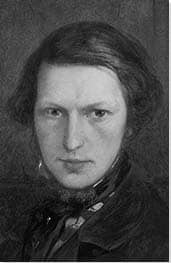Summary of Ford Madox Brown
Brown's name is firstly associated with Britain's most important nineteenth century art movement, the Pre-Raphaelite Brotherhood (PRB), for who he acted as a sort of mentor and associate rather than an "official" member. Like the young rebels in the PRB, Brown kicked against the "artificial" history paintings being endorsed by the British Academy by committing to an uncompromising realism. But unlike the PRB, who tended towards religious and medieval subjects, Brown's painting was driven predominantly by modern world matters, and especially the lives of the working classes living in Victorian England. Reflecting several personal tragedies, his earlier works were executed in muted colors and sombre tones. But his "discovery" of Hans Holbein, and a chance meeting with members of the holy Nazarene movement, saw his palette blossom almost overnight. He executed all future works, including landscapes, and his more famous "social commentary" pieces, The Last of England (1855), and Work (1852-65), in a more animate realist style.
Accomplishments
- Brown was a major influence on the Pre-Raphaelite Brotherhood. A tutor to Dante Gabriel Rosetti, and a friend and (mutual) admirer of William Holman Hunt, he was a supporter and inspiration for a group that was the first to mount a serious challenge to the excesses of the Academy historical painting. The group's exploration of pictorial realism anticipated the shift away from academic painting that was to dominate late nineteenth century European modernism.
- Brown was influenced by the renowned essayist Thomas Carlyle (the so-called "Head of English Letters"). He took from him the maxim that there was a "nobleness" and "sacredness" to manual work. Although Brown is (rightly) placed in a linage with William Hogarth, he nevertheless eschewed Hogarth's "disingenuous" preference for satire and wit for an observational style of painting that preserved the "inherent dignity of the British labourer".
- Reflecting his own wretched life experiences, Brown's early work are defined by muted colors and a preference for the "unadorned reality" of Byronic (characteristic of the poetry of Lord Byron) historical tragedy narratives. Only later, having absorbed the influence of Hans Holbein and the Nazarene school, did his palette start to accommodate a more expansive color scheme which he used to breathe new life into narratives that celebrated the lives of the ordinary Victorian citizen.
- Brown collaborated on several projects with William Morris, the driving force behind the Arts and Crafts Movement. He co-founded with him the design company, Morris, Marshall, Faulkner & Co. Under its auspices he produced a range of stained-glass windows and hand-made furniture items. These pieces were of such quality his reputation as a decorative arts practitioner merely confirmed his standing as arguably England's most multitalented working artists.
- Not only did his realist approach deliver a blow to the Academy standard, Brown also took the exhibition of his art into his own hands. He set a new precedent by becoming the first British painter to organize and promote a successful independent exhibition of his work.
The Life of Ford Madox Brown
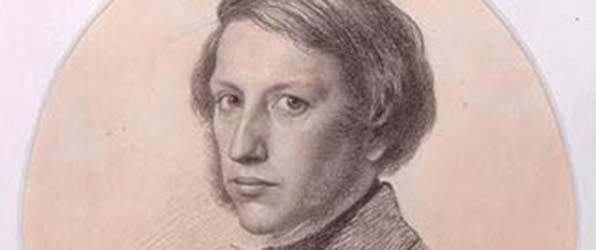
For Brown the role of the artist was clear, it was not artistic folly but rather moral righteousness: "I would have you beware of that dangerous and unrestrained tendency to wit which neither makes us wiser nor happier, nay is positively suicidal."
Important Art by Ford Madox Brown
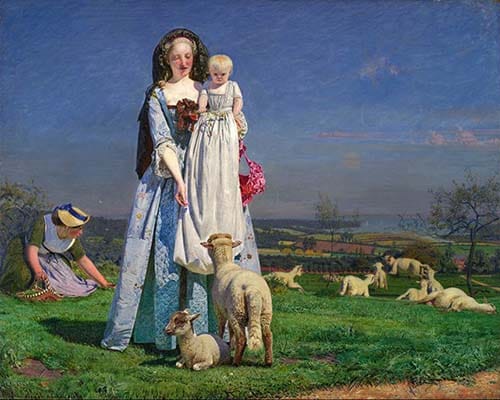
Pretty Baa-Lambs
This pastoral image depicts a woman and child on a sunny day feeding lambs in the foreground whilst a maid picks the flowers behind them (perhaps to be given as feed). More lambs frolic in the background, which leads our eyes to the expansive patchwork landscape which boasts the achievements of nineteenth century agriculture. There is a great blue sky in sight, mimicked in the paler blue dress of the woman in the foreground and the pinafore of the maid on the left. There are white fluffy clouds which similarly mirror the coats of the bounding lambs. The overall image is Rococo-like in its saccharine stylings; there is a pink satin bonnet in the lady's hand and the purity of the lambs being fed by a mother and child demonstrate a resounding sweetness to the image. It is almost shallow in its sugary over-sentimentality. However, as the nursery-like title suggests, we can deduct that this image is meant for, and centres around, the world of the child. It is a serene depiction of family life, precious and calm. Children can feel safe in this sun-kissed scene.
The painting resides in Birmingham Museums and Art Gallery who have said about the painting that the models were in fact Brown's second wife Emma and their first daughter, Catherine. It was one of the early en plein air paintings, making Brown something of a pioneer. The outdoor method comes across in the attention to detail: the stunningly bright lighting and patchy imperfect grass. Author and art historian Virginia Surtees published Brown's letters in which he said that the work was painted on South London's Clapham Common. He even took the liberty of renting the lambs from a farmer each day. The figures are in eighteenth century dress, an idea he had previously explored in paintings in recent years. This is perhaps to evoke a time before mass industrialisation; nature, although organised into an agricultural patchwork in this painting, is here shown as vast and evocative of a feeling of purity and at oneness.
Oil on panel
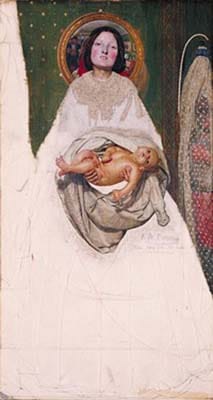
Take Your Son, Sir
This unfinished work is split into two diagonal parts; the bottom is just a series of rough sketches on pale canvas which we can just about make out to be the plans for a crinoline skirt. The top part, however, is rendered in fine detail, typical of Brown's stylings. The background is luxuriously adorned, and the lady's head is framed Madonna-like by a halo made by the convex mirror. It is reminiscent of the famous Arnolfini Portrait by Dutch Renaissance painter Jan van Eyck. The mirror also reveals to us the reflection of an interior with a male figure on the left, mimicking the staring gaze of the viewer. He does however hold out his hands to accept the new-born child, thus assuming the role of the father. The woman herself looks pale with mottled rosy cheeks. We are unsure whether the baby is hers, but her pale complexion implies she could have just given birth and is now in a state of exhaustion. The baby looks befuddled but healthy, with a yellow-pink tinge to its skin which offers a contrast to that of the woman. The lighting that Brown has deployed is of a rather bright quality thus the dark black eyes of the child hold our attention rather than the woman's drooping lids.
This uncompleted painting has a tragic history. London's Tate Britain gallery states that Brown stopped painting this image after the death of his own son, Arthur, in 1857. His second wife, Emma, had been pregnant at the time of painting so it is reasonable to assume that the man in the mirror is the artist himself. Brown was a realist - despite referencing paintings past, he gives us an image of a woman of this world, in an interior of his time - and there are very few such raw depictions of childbirth. Feminist art historian Marcia Pointon says that this painting is truly charged with life and death. "It is about Madox Brown's own confrontation with femininity. Its discourse centres on the contradictions between parenthood, home-making, the raw realities of procreation and the artist's own sexuality. The embryonic child is both a reward and a threat: 'Take your son, sir'".
Oil on canvas
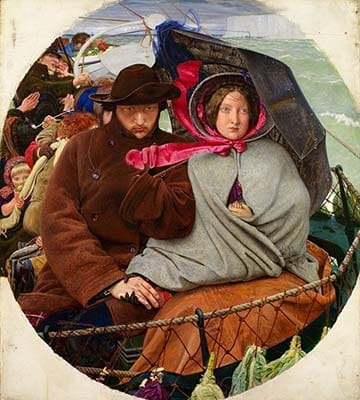
The Last of England
This tondo (round painting) depicts a couple as they embark on a voyage (the iconic White Cliffs of Dover are behind them) to the far-flung lands of Australia. The protagonists are dressed in sturdy winter clothes which, with the pink silken ribbon tied around the woman's bonnet, confirms their middle-class social standing. However, we see that this is a mixed social group once we observe the travellers who sit behind them on the crowded vessel. When we look closer we see a glimpse of a small hand emerging from the woman's shawl - the couple are in fact a family of three. There is a selection of cabbages in the foreground which would have been to prevent scurvy and rickets; common diseases at sea in the nineteenth century. Their presence also confirms the length of the journey ahead. There was mass emigration from the UK to Australia at the time, caused in part by stories of a gold rush and, even without the promise gold, the hope of a new (and better) life. (Tate Britain say that Brown was considering emigrating himself at that time, though his preference was for the British colonies in India.)
The painting was inspired by the departure of Brown's friend Thomas Woolner, the Pre-Raphaelite sculptor, who had left for Australia. The two models are in fact Brown and his second wife, Emma Hill. He even modelled the protruding hand as his own child's hand. Historian Francis Fowke notes that "Following the Pre-Raphaelite prerequisite of truth to nature, Brown painted the bulk of the picture out of doors and asked his wife to sit in all weathers, even when there was snow on the ground". His incredible attention to detail is palpable in this painting; not least the natural light on a grey and tempestuous sea that conjures the harsh journey ahead. This is a journey that requires strength of heart, one that could see no return. For that, their stoicism in face of the unknown gains the viewers' sympathy.
Oil on panel
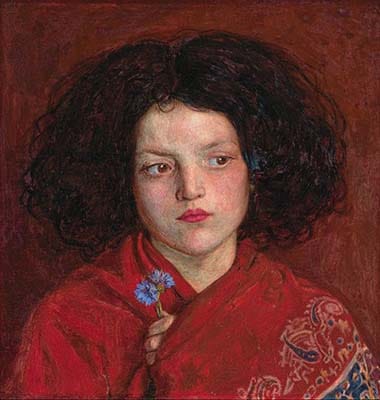
The Irish Girl
This portrait depicts a young girl from the chest up, posed frontally but looking off to her left. She is lost in thought. We wonder: is she concerned? Pensive? Scared? Certainly, she is preoccupied and it is her mystifying gaze that holds our curiosity. The girl clutches at two blue cornflowers which poke out in contrast to the luxurious red of the girl's shawl and the painting's deep red background. This same reddened hue is accented in the young girl's slightly pursed lips - she is full of life and we cannot help but admire her youthful zest. Her hair is unkempt, hinting at the fact that she could be of a lower-class group. Her pale skin and dark hair are in fact typical of Irish colouring (The Irish Girl of the title) and her essential character is here venerated by Brown who paints her in his customary transparent style.
Madox Brown was searching for Irish subjects for his seminal painting Work (1852-65) when he stumbled upon this charming young orange seller. The Yale Centre for British Art informs us that this work was a product of the sum of money that Leeds stockbroker P.E. Plint had given Brown for the completion of Work. The Centre also notes that "The Irish Girl reflects a trend among collectors in the latter half of the nineteenth century for small 'cabinet pictures,' which were focused studies (suitable for domestic interiors) of individual women or children [...] This portrait holds an interesting duality as a kind of social study but also a triumph Brown's formal qualities. The complimentary colours of the cornflowers, pale skin, and red features throughout don the painting an almost oriental feel, the work is resoundingly aesthetically victorious".
Oil on canvas laid on board
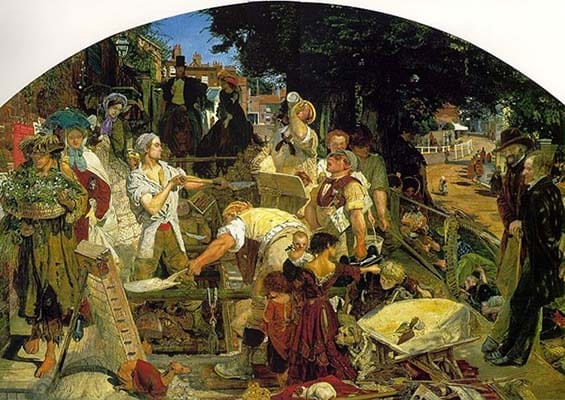
Work
This sunlit scene is dense with figures from all walks of contemporary life engaged in various pursuits. For instance, in the centre position there are labourers who toil in the midday sun with sleeves rolled. One of them wears a rural smock, telling us he was recently a countryman who had perhaps moved to the city to fill the demand for work in rapidly industrializing London. In front of them, meanwhile, are children ducking through the scene as the eldest girl, holding a baby in her arms, appears to be trying to keep them in check. Her back is to us despite being at the forefront of the scene. Animals, too, dance around their feet. On the far left is a plant-seller (also poverty-stricken judging by the lack of shoes) who looks shiftily across the picture plane. In contrast to the lower class figures who dominate the middle foreground, there are two scholarly types on the right, well-dressed and observant of the scene that is unfurling before them. Similarly well-dressed are the other figures towards the back of the painting, two women on the left (one claimed by Brown in his hand-written exhibition pamphlet to be Emma, his second wife), the other offering a religious tract to one of the working men.
This painting formed the centrepiece of his one-man retrospective. Brown put on the exhibition as a protest against the grip the Academy held over the current art scene and was widely applauded for his daring and for his success at providing a precedent for non-Academy exhibition of art.
The painting itself was inspired by Thomas Carlyle's book Past and Present, who he depicts on the right as one of the scholars alongside F.D. Maurice, another social reformer. Academic Gerard Curtis notes that Brown had given more details of the children in the painting in his exhibition pamphlet. He explained that they were orphans, their mother having died because of the lack of sanitation in London's water, and their father having left them due to a drinking problem. Curtis writes: "These children, who stand before the water pit, represent the toll of cholera, disease, impure water, and, significantly, alcohol, on working-class families and their innocent offspring. They may also represent Brown's concerns in 1854 for his own children catching the disease, or, more specifically, his anxieties over his wife catching cholera".
Oil on canvas
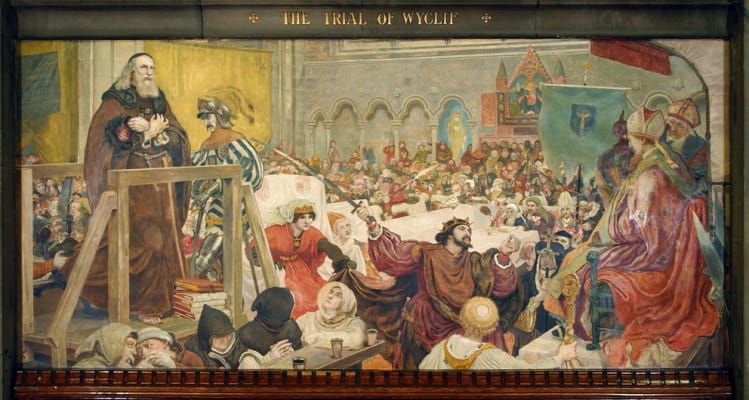
The Trial of Wycliffe
This, by most historians' accounts, is the finest of the Manchester Murals. Brown biographer, Ford Madox Ford (the artist's grandson) called it "the most ambitious and perhaps the most successful of all the twelve [murals]". The reformer John Wycliffe stands on trial charged with heresy, with his patron John of Gaunt, Earl of Palatine of Lancaster and son of the King, taking a stand to defend him. The artist himself put the success of the mural down to what he called its "subsidiary action to the dramatic center" which, he continued, was "almost as enormous as that which is displayed in Work". For instance, (the famous English poet) Chaucer, the Duke's other protégé, is also represented; shown taking notes in a green hood, just behind John of Gaunt's left hand, and apparently modelled on the artist's old friend Rossetti.
Brown used a new method of fresco painting developed by the British artist and art collector, Thomas Gambier Parry. The Gambier Parry Process, as it became known, used the technique of painting on prepared lime plaster. Paint pigments fixed to the carbonatation of the lime (calcium hydroxide) thus overcoming the problem of attracting excessive dirt and dust that was the blight of conventional fresco coloring. Brown was very much involved with new developments in painting and saw his murals as the most significant application of the new method to date. The Manchester Murals were in fact part of a fresco revival underway in England with the new Houses of Parliament (completed in 1860) also adorned with frescoes (although these were painted using the older technique).
Brown thought that Wycliffe was both an "innovator and thinker of great originality" and one of "the greatest scholars of his age". But as historian John Archer says, "it is ironic because, as an admirer of Wycliffe, Brown held different views to those of the accusing clerics. Wycliffe had eschewed position and even comfort to support the ordinary people, attacked clerical privilege, and would finally be martyred for his pains. He had a huge appeal at a time when medievalism was in the air, and the Reformation stood out as the key event of the past. No wonder this mural is so powerful". Curator and art historian Julian Treuherz concludes that, as these paintings were being created at the end of Brown's life, a few of them were painted on canvas rather than directly onto the wall as he was experiencing deteriorating health and had to move back to London having lived in Manchester for several years on account of his research.
Mural
Biography of Ford Madox Brown
Childhood
Ford Madox Brown was born in 1821 in Calais (France), to English parents, Ford Brown, a Ship's Purser (or ship's banker and accountant), and Caroline Madox. They had experienced financial difficulty in England and decided to move to the Northern French city for a more affordable lifestyle. The Browns also had an older daughter, Elizabeth Coffin. France in the 1820s was a country in the grip of industrialization. Paris became one of the world's first cities to be lit by gas and Brown was captivated by France's glistening new capital. These years of transition tended to divide opinion: those who embraced the industrial age and those who resisted it. This theme (the rise of the industrial age) would be a subject that occupied his painting career, as would his humble upbringing on the French coast.
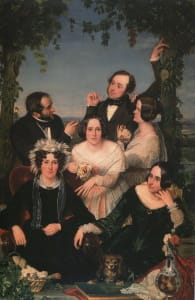
His childhood education was rather disorderly with the Browns moving regularly between Calais and Caroline Madox's family home in Kent (England). Ford Brown had been keen for his son to pursue a naval career, but Brown had shown a fine talent for drawing copies of old masters' prints. In particular, he was inspired by the drama in the pictures of William Hogarth. The family moved to the Belgian town of Bruges in his late teenage years to finetune Brown's already impressive artistic expertise at the Dutch art academy De Vrije Academie (existing still today as De Stedelijke Academie). At the time the school was chaired by Albert Gregorius, a successful Flemish-Belgian portrait painter who assumed the role of Brown's first mentor.
Early Training and Work
After a year in Bruges, Brown moved to Ghent to study under Pieter van Hanselaere, another renowned portraitist but notable also as a painter of historical and religious scenes. From there, Brown moved to Antwerp the following year to study with Gustaf Wappers, a celebrated artist who is thought to have been the first Romantic painter of note in Belgium. Romanticism was rife in European painting of the period - it promoted an emotional sensuosity as well as an appreciation for the awe and beauty of the natural world. It exerted a very heavy influence over the eighteen-year-old Brown until the setback of the death of his beloved mother in 1839.
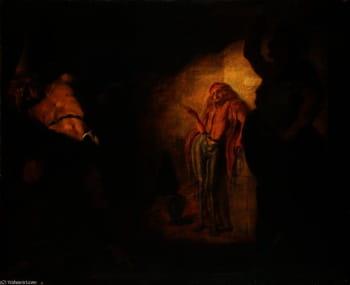
In 1840, Brown moved to Paris, where he honed his drawing skills by copying Old Masters in the Louvre museum. During his time in Paris, Brown exhibited at France's Royal Academy. Tragedy struck again in 1841 and 1842 with, respectively, the death of his sister, and the death of his father. Amidst these terrible events, Brown married his cousin Elizabeth Bromley in Kent (in 1841). Tragedy followed again, however, when the couple's infant daughter died also in 1842. This "Byronic" (characteristic of the poetry of Lord Byron) state of mind gave rise to a moody and brooding outlook on the world, and one that was fully justified given the events that had blighted Brown's personal life.
He arrived back in London in 1844 with his wife and second daughter. Not surprisingly, perhaps, works of this period were characterized by the theme of death and he was known to have sketched corpses at the university college hospital in London. Also in 1844, Brown entered a competition to win a commission to decorate the interior of the Houses of Parliament. His bid failed and the following year he headed for Rome. He stopped in Basel en route and here discovered the work of the famous portraitist Hans Holbein. Known as a sublime colorist, Holbein was to have a significant impact on Brown's future work.
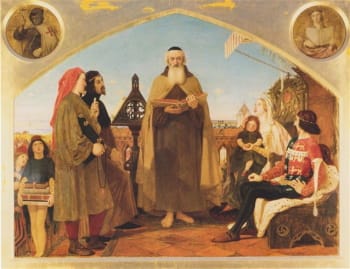
Brown arrived in Italy in 1845 and was introduced to Friedrich Overbeck and Peter Cornelius, both of whom were making works associated with the devotional Nazarene movement (Nazarene: after the inhabitants of Nazareth, Christ's hometown). The pious Nazarenes were themselves inspired by artists of the Middle Ages and the Renaissance and were, like Brown, reacting against Academy dogma which at that time supported the fashion for Neoclassicism. As historian Amy Tikkanen writes, "This meeting undoubtedly influenced both Brown's palette and his style. His interest in brilliant, clear colour and neomedievalism first appears in Wyclif Reading His Translation of the Scriptures to John of Gaunt (1847)". Sadly, on the journey home to England, yet another tragedy struck when Elizabeth, his wife, died of tuberculosis.
Brown exerted great influence over a younger artist (some eight years his junior) called Dante Gabriel Rossetti who even requested him as a tutor. Historian Virginia Surtees published one of the Brown's letters (dated 1848) in which he wrote: "curious enough he [Rossetti] wrote to ask me to give him lessons, from his opinion of my high talents he knew every work I had exhibited [...] will see what we can make of him". The mentoring was, however, short lived even though the two artists corresponded for many years. Rosetti would go on to co-found, with John Everett Millais and William Holman Hunt, the Pre-Raphaelite Brotherhood, one of England's most influential art movements. Hunt was also a friend and admirer of Brown, with Brown himself known to be a supporter of Hunt's paintings and his moral and naturalistic take on picture making. Though never a formal member of the Brotherhood, Brown did contribute to the Pre-Raphaelites' magazine, Germ, in 1850.
Mature Period
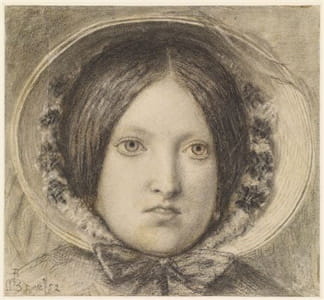
Forward of the late 1840s, Brown produced a series of works of the model Emma Hill. She became his lover and they had their first child together, Catherine Emily, in 1850. The couple married later in 1853 and had a second child, Oliver Madox Brown, in 1855 (Emma gave birth to a son in 1856 but he passed at only ten months). Meanwhile, Brown was "at war" with the Royal Academy (who themselves were critical of his work) and in 1858 recruited members the now disbanded Pre-Raphaelites into an "anti-Academy" society of artists, and non-artists, in the Fitzrovia district of London. He named the society the Hogarth Club after his childhood hero. Although inspired by Hogarth's social commentaries, Brown baulked at Hogarth's liking for satire and caricature and chose instead to treat his working-class subjects with a candour and respect that was befitting of their station in life. The Hogarth Club provided an alternative meeting place and exhibition venue for London based and provincial members who were united in their disdain for an "official" Royal Academy standard.
The Hogarth Club lasted just three years (1858-61) but in that time it brought together Brown, Edward Burne-Jones and William Morris (founder of the famous Arts and Crafts Movement). In 1861 he was (with Morris) one of the founder investors in the decorative arts company, Morris, Marshall, Faulkner and Co. Brown produced several stained-glass windows and handmade furniture items for the company. His involvement with the company brought him further kudos and he was now wealthy enough to purchase a fashionable residence in the upmarket Fitzroy Square in central London.
There is little doubt that Brown's most important painting is Work, which he began in 1852 but was only completed in 1865. It was unveiled at a one-man retrospective that was something of a pioneering event for its time. Brown single-handedly organised the event, even writing of the exhibition brochure himself. He had fully asserted his independence from the Academy, and, in the spirit of Hogarth, had used his art to chronicle the noble lives of the working classes. The exhibition was a great success and was hailed by many of his peers as a revolution in arts exhibition.
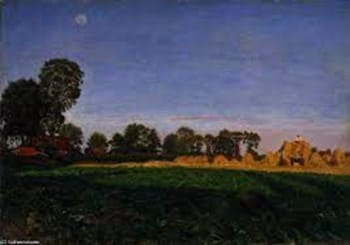
Although he was primarily focused on urban scenes, Brown also painted landscapes. Indeed, commenting on Carrying Corn (1854), the art historian John Rothenstein wrote: "Recent criticism [he was writing in 1958] has begun to place the Pre-Raphaelites in a wider context than had been the case hitherto and to see the style which they so suddenly evolved not as an isolated English manifestation - whether mere eccentricity or flash of genius - but as part of a European movement aiming at clarity and exactness and with medieval preoccupations perceptible, for instance, in the work of the German Romantics and that of Ingres".
He saw Brown as a truly pioneering figure who, with the other artists associated with the PRB, anticipated "the realist impulse which moved Courbet and the Impressionists to transform the painting of the Western World". Indeed, of Carrying Corn he asked: "whom, on the continent of Europe [...] made in the year 1854 so uncompromising an essay in art [namely Carrying Corn] of representing landscape under full sunlight, with the violet shadows, generally accepted as an Impressionist discovery? Not Courbet or painters of the Barbizon". In making his case, Rothenstein added that "the oldest Impressionist Degas was still a law student and Pissarro had not [yet] arrived in Paris", while the first Impressionist Exhibition still lay some "twenty years ahead".
Late Period
After Work, and his well-received retrospective, much less is documented about Brown's life. His medical records tell us that he suffered from gout from 1868 onwards and he suffered a small stroke in the same year. Although his involvement with the design firm only lasted a few years, Brown still collaborated with Morris in the following years. He made furniture, made illustrations and even produced some stained glass alongside Edward Burne Jones in several locations throughout the UK. It is widely thought that Brown was profoundly devastated by the death of his third child, Oliver (known affectionately as "Nolly") who succumbed to blood poisoning in 1874 aged just nineteen.
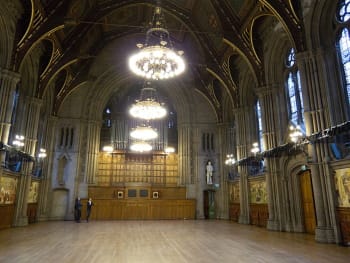
In 1878 Brown secured a major commission for a series of murals for Manchester Town Hall. This project would occupy him until the end of his life. From 1881 to 1887 he moved between London and Manchester and selected his subjects from views of the city streets. The mural depicts twelve scenes from the earliest known history of Manchester including: The Romans building a fort at Mancenion; The Expulsion of the Danes from Manchester; The Establishment of Flemish Weavers in Manchester; and The Trial of Wycliffe, which is the most renowned of all the murals. In 1890 Emma Hill died in Primrose Hill, North London. In 1893 Brown completed the Manchester murals before joining Emma later that year following a fatal stroke. He was interred at St Pancras and Islington Cemetery.
The Legacy of Ford Madox Brown
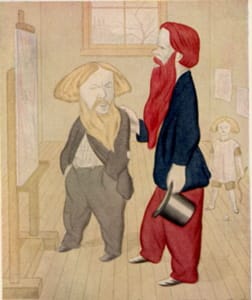
Brown was one of the most eminent English painters of the nineteenth century and an iconic figure in the social history of Victorian art. He is viewed by many as natural heir to William Hogarth although, unlike his childhood hero, Brown was averse to social satire and wit and treated his subjects rather with a reverential-like respect. He was an associate of, and, indeed, early inspiration to, the Pre-Raphaelite Brotherhood movement and with them provided a viable alternative to Academy Art and its preference for overblown historical paintings. While seen by many as a uniquely British movement, historians such as Rothenstein have argued in fact that the PRB, and Brown especially, deserve credit for anticipating the shift towards realism that was about to consume artists on the European continent (especially in France) in the late nineteenth century.
Through his formation of the Hogarth Club, meanwhile, Brown established a meeting place and exhibition venue for those artists and intellectuals who wanted to challenge the dominance of "official" Academy art. He was hailed as a pioneer amongst his peers for his audacious move to put on the first "one man" arts exhibition in the country. By doing so, indeed, he had effectively set a precedent for independent arts exhibition in Britain. His paintings, which he married with a highly successful excursion into the decorative arts, merely confirmed his standing as one of the most import English artists of the second half of the nineteenth century.
Influences and Connections

-
![William Hogarth]() William Hogarth
William Hogarth -
![William Holman Hunt]() William Holman Hunt
William Holman Hunt - Lord Byron
- Friedrich Overbeck
- Peter Cornelius
-
![William Morris]() William Morris
William Morris ![Edward Burne-Jones]() Edward Burne-Jones
Edward Burne-Jones- Thomas Woolner
-
![Renaissance]() Renaissance
Renaissance -
![The Pre-Raphaelites]() The Pre-Raphaelites
The Pre-Raphaelites - The Nazarenes
-
![William Morris]() William Morris
William Morris ![Edward Burne-Jones]() Edward Burne-Jones
Edward Burne-Jones- Max Beerbohm
Useful Resources on Ford Madox Brown
- The Art of Ford Madox BrownBy Kenneth Bendiner
- Ford Madox Brown: Pre-Raphaelite PioneerBy Julian Treuherz
- Into the Frame: The Four Loves of Ford Madox BrownBy Angela Thirlwell
- Ford Madox Brown, the Manchester Murals and the Matter of HistoryBy Colin Trodd
 Ask The Art Story AI
Ask The Art Story AI